Fill the summer/autumn feed gap – WA
The issue
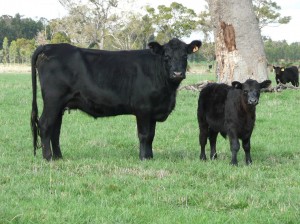
One of the key drivers for producers adopting perennial pastures is to reduce supplementary feeding over the summer and autumn period. Traditional annual based pastures provide adequate feed over winter and usually surplus feed over spring. This surplus is cut for hay or silage to be fed back to stock outside the annual pasture growing season.
Perennial pastures can reduce supplementary feeding during the summer/autumn period by providing green feed. They extend the growing season by producing feed earlier than annuals and growing past the end of spring into summer. Summer-active species also grow in response to summer rainfall and summer moist soils. Apart from reducing supplementary feeding, perennials can also open up new opportunities for finishing young stock earlier or increasing stocking rate.
Findings from the EverGraze Albany Proof Site (see Figure 1) showed that;
- Kikuyu recorded the highest dry matter production at the EverGraze Proof site during summer with 1100 kg DM/ha.
- Perennials have the ability to extend the growing season with growth rates of 10kg DM/ha/day or better in November and December.
- Modelling suggests that 10-20 kg DM/ha/mm rainfall can be grown in summer/autumn
- Lucerne and chicory have a dry matter digestibility of over 70% during summer and autumn
- Perennial swards provide similar annual dry matter production to annuals at around six tonnes DM in a standard year for Wellstead, but do so over a longer period.
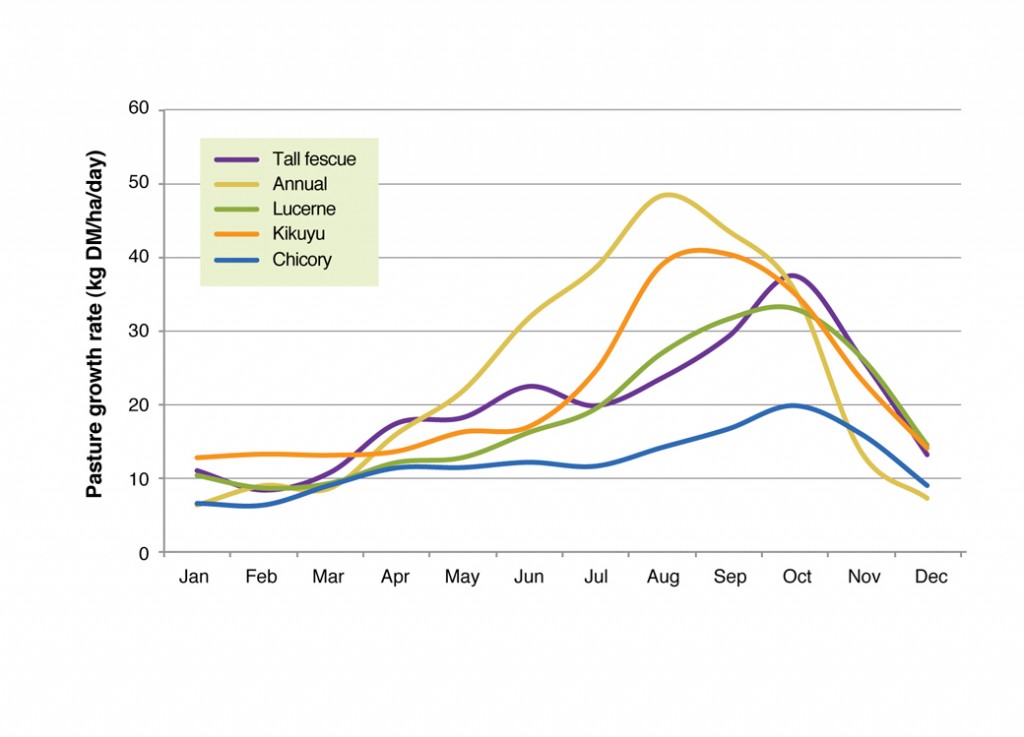
Proof Site findings
Trials at the Albany Proof Site showed that three species from the site that were able to consistently produce substantial quantities of out of season feed. Modelling based on the Proof Site findings and climate records (1970-2010), showed that kikuyu produced the most out of season feed due in part to its deep root system, ability to respond to out of season rainfall and capacity to provide more dry matter per millimetre of water.
Table1: Modelled Out of season growth (kg DM/ha) from 1970 – 2010
| Kikuyu | Lucerne | Chicory | |
| Summer | 1217 | 1022 | 672 |
| Autumn | 1320 | 1050 | 977 |
Lucerne also produced a significant amount of out of season feed along with chicory. Although the chicory and lucerne produced less feed than kikuyu, the dry matter digestibility (see Figure 2) and crude protein was higher, sufficiently to grow animals out of season. This can provide producers with alternative livestock options, like finishing systems to produce out of season lambs.
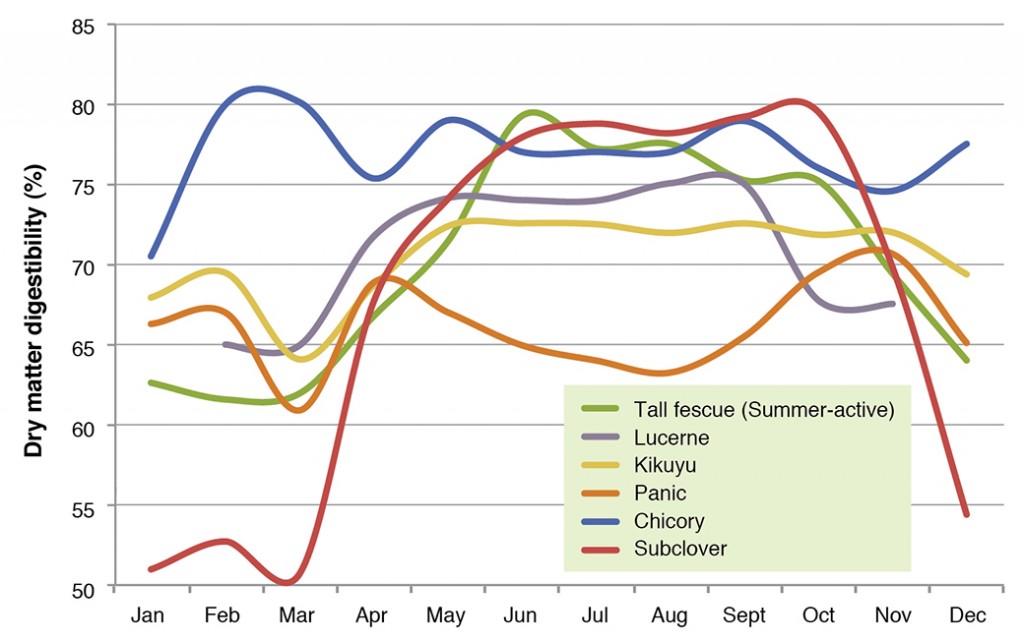
Panic was also established on the site. It was only a small area used for lambing however, despite the very poor sandy soil, the sward increased in density and production. It definitely showed promise over a tough three years. Panic has a similar growth period and quality profile to kikuyu. However unlike kikuyu, it is able to put on bulk without losing quality. Unfortunately, while panic is tolerant of grazing, it is not as tolerant as kikuyu and requires rotational grazing to maintain plant density.
What perennials where?
The results from the Albany Proof site demonstrated the potential for out of season production, however each region and farm is different. Perennials must be chosen based on suitability to purpose, soil type, rainfall and management.
If producers want out of season production, perennial pastures should have summer activity matched with a winter-active annual, for example; kikuyu and subclover (see table 2). Summer active species like kikuyu, panic, lucerne and chicory will be able to respond to out of season rain and produce fodder of varying quality.
Table 2: Pasture species and their characteristics
| Species | Ideal soil type | Ideal rainfall (mm) | Winter growth | Summer Growth | Feed Quality |
| Lucerne | L, S* | 350+ | G | A | VH |
| Chicory | L, S | 450+ | G | A | VH |
| Kikuyu | S | 500+ | P | VA | G |
| Rhodes Grass | S | 400+ | P | VA | G |
| Panic | S | 500+ | P | VA | G |
| Tall wheat grass | C, L, S | 400+ | G | A | G |
| Phalaris | L, C | 500+ | VA | D | H |
| Tall fescue (winter active) | L | 500+ | VA | D | H |
| Tall fescue (summer active) | L | 600+ | M | VA | H |
From the Perennial Pastures: Rules of Thumb
Soil: L-loam: S-sand, C-clay
Winter Growth/feed quality: P-Poor, M-Moderate, G-Good, H-high, VH-Very High
Summer Growth: D-Dormant, A-Active, VA-Very Active
*not suited to pale deep sands
The sub-tropical grasses will, with appropriate summer moisture and management, provide moderate to good quality feed for maintaining animals, and in some cases provide modest levels of growth. Kikuyu and panic are both proven performers that have been adopted across the southern and northern coastal areas of WA.
The amount of forage produced is reliant on the amount of out of season rain or moisture available in the soil profile. Without out of season rain, perennial pastures will extend the growing season, but will not provide substantial amounts of feed.
Maintaining a good annual component is critical to having a productive pasture sward. Subtropical grasses particularly, will produce less biomass over winter, which means that maintaining desirable annual grasses and clovers in the sward is critical. This can be achieved through heavy grazing in late autumn to open up the stand (especially kikuyu), allowing space for annual seedlings to grow. Some producers are also experimenting with suppressing kikuyu in autumn using herbicides. This is particularly useful in older stands of kikuyu where chemical suppression seems to be increasing the annual component in the sward and encouraging new kikuyu growth.
Temperate perennial grasses do have a role in WA. Tall wheat grass is perhaps the most common, however for parts of the state that receive more than 500mm rainfall, other perennial grasses like tall fescue (winter and summer active) and phalaris may have a role. These grasses generally have better winter growth, frost tolerance and moderate to negligible summer growth, making them well suited to winter dominant rainfall zones. They typically have good nutritional value but require rotational grazing to maintain plant density.
On fertile loams the winter and summer active tall fescues have been proven to persist well and produce more forage than annual pastures alone. Phalaris is also suited in these areas and would have application in heavily waterlogged areas across the >550mm rainfall zone. However, be aware that phalaris can poison stock if it is not managed correctly.
Influence of soil type/soil constraints
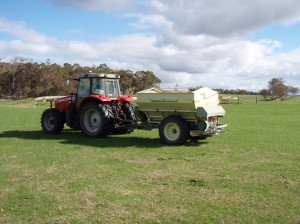
Soil type will impact on species selection and growth. As can be seen in table 2, perennial pasture species have varying preferences for different soil types. For instance, kikuyu appears to grow best on deep well drained sands, while lucerne prefers loams and clays. Lucerne will grow on deep sands but will not generally be as productive. Plant density reduces if the sand is acidic. It is critical to match the perennial to the soil type.
This applies to soil constraints as well. Issues like soil acidity, water logging and salinity will affect potential pasture options. Careful consideration needs to be given to any tolerance issues that affect species, and whether soil amelioration or other types of intervention are required.
Livestock demand
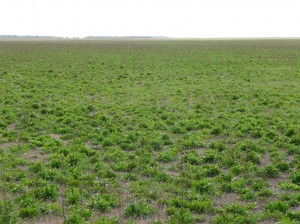
Different perennials will perform different roles with the farming system, so it is important to select the right species for the job. Considerations include requirements for management and the capacity to produce quality and quantity feed. The key is to match the plant to the purpose.
Kikuyu, for example, can produce green feed outside the growing season. It is hardy and will maintain animals thus reducing the need for supplementary feeding. However, at best it will only support modest animal growth due to a moderate digestibility of 55 to70%.
Lucerne is a different proposition. Like kikuyu, it produces out of season feed, however, as a consequence of its higher digestibility (65-75%) and crude protein (15-25%) it can grow animals. It is therefore suited to driving weight gain and finishing animals.
Further Information
- EverGraze Exchange – Proven and Promising Perennials for WA
- EverGraze Action – Growing and using Kikuyu in WA
- EverGraze Action – Growing and Using Chicory in WA
- EverGraze Action – Growing and using lucerne
- EverGraze Action – Growing and using winter active Tall Fescue in southern Australia
- DAFWA Website, Perennial Pastures
- Salt Land Genie
- Perennial Rules of Thumb
- Perennial Pastures for Western Australia, Bulletin 4690

